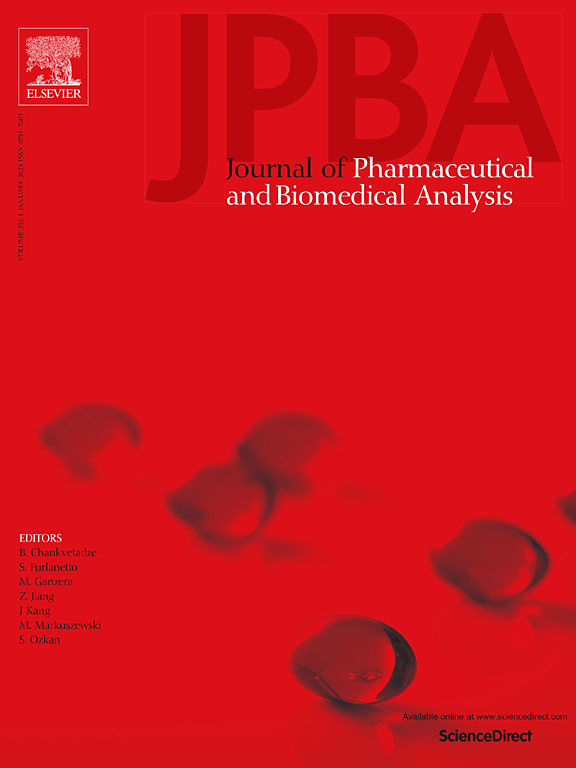An exploratory multi-omics study reveals distinct molecular signatures of ulcerative colitis and Crohn's disease and their correlation with disease activity
IF 3.1
3区 医学
Q2 CHEMISTRY, ANALYTICAL
Journal of pharmaceutical and biomedical analysis
Pub Date : 2024-12-25
DOI:10.1016/j.jpba.2024.116652
引用次数: 0
Abstract
Clinically heterogeneous spectrum and molecular phenotypes of inflammatory bowel disease (IBD) remain to be comprehensively elucidated. This exploratory multi-omics study investigated the serum molecular profiles of Crohn's disease (CD) and ulcerative colitis (UC), in association with elevated fecal calprotectin and disease activity states. The serum proteome, metabolome, and lipidome of 75 treated IBD patients were profiled. Single- and multi-omic data analysis was performed to determine differential analytes and integrative biosignatures for biological interpretations. We found that chronic inflammation, phosphatidylcholines and bile acid homeostasis disturbances underlined the differences between CD and UC. Besides, elevated calprotectin was associated with higher levels of inflammatory proteins and sphingomyelins (SM) and lower levels of bile acids, amino acids, and triacylglycerols (TG). Relative to the remission disease state, the active form was characterized by decreased abundances of SMs and increased abundances of inflammatory proteins and TGs. We also observed that molecular changes upon treatment escalation were putatively related to altered levels of inflammatory response proteins, amino acids, and TGs. ISM1, ANGPTL4, chenodeoxycholate, Cer(18:1;2 O/24:1), and TG were identified as candidates subject to further investigation. Altogether, our study revealed that disturbances in immune response, bile acid homeostasis, amino acids, and lipids potentially underlie the clinically heterogeneous spectrum of IBD.
一项探索性多组学研究揭示了溃疡性结肠炎和克罗恩病的不同分子特征及其与疾病活动的相关性。
炎症性肠病(IBD)的临床异质性谱和分子表型仍有待全面阐明。这项探索性多组学研究调查了克罗恩病(CD)和溃疡性结肠炎(UC)的血清分子谱,它们与粪便钙保护蛋白升高和疾病活动状态有关。对75例接受治疗的IBD患者的血清蛋白质组、代谢组和脂质组进行了分析。进行单组学和多组学数据分析以确定差异分析物和生物解释的综合生物特征。我们发现慢性炎症、磷脂酰胆碱和胆汁酸稳态紊乱突出了CD和UC之间的差异。此外,钙保护蛋白升高与炎症蛋白和鞘磷脂(SM)水平升高以及胆汁酸、氨基酸和甘油三酯(TG)水平降低有关。相对于疾病缓解状态,活性形式的特征是SMs丰度降低,炎症蛋白和tg丰度增加。我们还观察到,治疗升级后的分子变化可能与炎症反应蛋白、氨基酸和tg水平的改变有关。ISM1、ANGPTL4、鹅脱氧胆酸盐、Cer(18:1;2 O/24:1)和TG被确定为有待进一步研究的候选。总之,我们的研究揭示了免疫反应、胆汁酸稳态、氨基酸和脂质的紊乱可能是IBD临床异质性谱的基础。
本文章由计算机程序翻译,如有差异,请以英文原文为准。
求助全文
约1分钟内获得全文
求助全文
来源期刊
CiteScore
6.70
自引率
5.90%
发文量
588
审稿时长
37 days
期刊介绍:
This journal is an international medium directed towards the needs of academic, clinical, government and industrial analysis by publishing original research reports and critical reviews on pharmaceutical and biomedical analysis. It covers the interdisciplinary aspects of analysis in the pharmaceutical, biomedical and clinical sciences, including developments in analytical methodology, instrumentation, computation and interpretation. Submissions on novel applications focusing on drug purity and stability studies, pharmacokinetics, therapeutic monitoring, metabolic profiling; drug-related aspects of analytical biochemistry and forensic toxicology; quality assurance in the pharmaceutical industry are also welcome.
Studies from areas of well established and poorly selective methods, such as UV-VIS spectrophotometry (including derivative and multi-wavelength measurements), basic electroanalytical (potentiometric, polarographic and voltammetric) methods, fluorimetry, flow-injection analysis, etc. are accepted for publication in exceptional cases only, if a unique and substantial advantage over presently known systems is demonstrated. The same applies to the assay of simple drug formulations by any kind of methods and the determination of drugs in biological samples based merely on spiked samples. Drug purity/stability studies should contain information on the structure elucidation of the impurities/degradants.

 求助内容:
求助内容: 应助结果提醒方式:
应助结果提醒方式:


